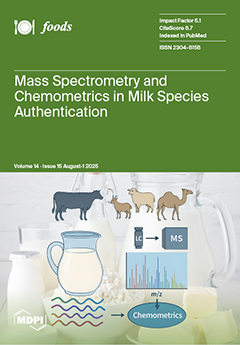The purpose of this study was to determine the effect of breed and sex (3 × 2) on the basic chemical composition, concentration of some minerals, and physicochemical properties of edible giblets of farm geese. The study material consisted of edible giblets (livers, gizzards, hearts) obtained from 42 geese from three Polish native breeds (Rypin, Suwałki, Kartuzy) at 220 weeks of age. Edible giblets were obtained during goose evisceration from seven males and seven females of each breed. Each bird was an experimental unit. Goose breed and sex had a significant effect on the chemical composition and physicochemical properties of the edible giblets. Rypin geese had higher (
p < 0.05) intramuscular fat content in the gizzard and heart, as well as higher protein content in the heart and lower water content in the gizzard, compared to Kartuzy and Suwałki geese. Kartuzy geese, in turn, had higher content of water in the heart, and higher concentrations of phosphorus, calcium, iron, manganese, sodium, and chromium in the liver, compared to Rypin and Suwałki geese. In turn, Suwałki geese had higher concentrations of phosphorus in the gizzard, and potassium, phosphorus, copper, and iron in the heart compared to the hearts of Rypin and Suwałki geese, while Kartuzy and Suwałki geese higher concentrations of sodium, magnesium, zinc, and manganese in hearts than the hearts of Rypin geese. In these studies, the highest lightness (
L*) was observed in the liver and heart of Rypin geese, the lowest yellowness (
b*) was observed in the gizzard of Suwałki geese, and the highest pH
24 and EC
24 were observed in the heart of Kartuzy geese. Regardless of breed, males had higher protein, collagen, and intramuscular fat contents in the heart, a higher water content in the gizzard, higher concentrations of potassium, and sodium in the liver and gizzard, copper in the heart and liver, and phosphorus in the gizzard, and less water in the heart and zinc in the liver, as well as higher (
p < 0.05) concentrations of iron in the liver and heart compared with females. The breed by sex interaction was significant for intramuscular fat and water content in the gizzard and heart, and protein content in the heart. Significant differences were also noted for EC
24 in the liver and heart, yellowness of the gizzard, and concentrations of most labeled minerals in edible giblets. The obtained results indicate that the nutritional value and suitability of edible goose giblets for the poultry industry vary depending on breed and sex. Due to the limited research on the chemical composition and physicochemical properties of goose giblets, further research in this area is necessary in the future.
Full article






